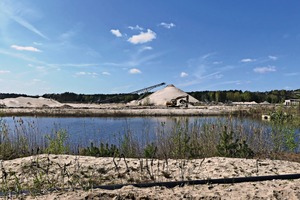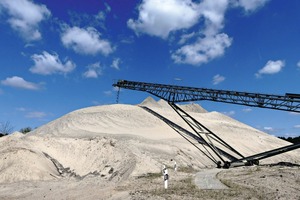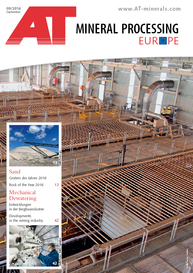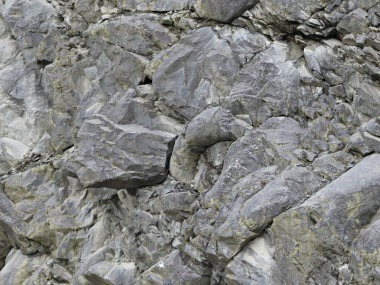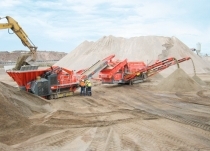Sand – Rock of the Year 2016
Tiny rock particles are making it big this year, a panel of experts under the direction of the Berufsverbandes Deutscher Geowissenschaftler (BDG – German Professional Association of Geoscientists) has chosen sand as “Rock of the Year 2016” in the tenth edition of this action. At the award ceremony, which took place on 22 April 2016 at the offices of the SKBB, Sand+Kiesunion GmbH Berlin Brandenburg, in Hartmannsdorf southeast of Berlin, the outstanding geological and economic properties of sand were elucidated in short talks, and during the subsequent tour of the extraction site and the plant, they were explored more deeply visually and haptically.
To heighten public awareness of rocks that are remarkable because of their geological origins and economic significance is the goal of the annual designation of important solid and loose rock as “Rock of the Year”. Since 2015, the Board of Trustees that decides on this top ranking has been part of the Federal Association of the German Mineral Resources Industry, MIRO, in cooperation with its state and regional associations. Through the extended cooperation of MIRO and BDG on this panel, the balanced assessment of the geological and economic qualities of the respective rocks is strengthened again. That the experts have unanimously awarded the top place to sand from different perspectives is not least down to its fascinating versatility (Fig. 1).
What is sand and how is it formed?
Sand is a loose rock of varying composition and form. It is defined on the basis of its particle size: particle mixes with a particle size range between 0.06 and 2 mm are classed as sand. As a purely natural product, its formation is the result of weathering and erosion of a wide range of rocks. Each grain of sand “tells” any observers with a knowledge of rocks of what it is made and whether it has been transported by means of wind, water or ice.
Who needs sand and for what?
Sand is of key economic importance for diverse industries (Fig. 2). In Germany, around 2120 sand and gravel plants are currently engaged in the extraction and processing of sands from near-surface deposits. This ensures the supply of sand to buyers close to the place of consumption, therefore making the operation economically and ecologically expedient over generally short distances.
The primary demand comes from the building materials industry and the building trade. But many other branches of industry need sand products. They have to have precisely defined properties for the production of concrete (ready-mix and prefabricated concrete elements), asphalt, sand-lime or aerated concrete blocks, mortar or screed. These properties are regulated in corresponding national and European standards. Each application requires that its specific quality criteria are met.
Sand with a particularly high silica content and corresponding purity is classified as “quartz sand”. The spectrum of those interested in this very high-grade raw material is wide. Depending on the mineral content and quality of the sand, they range from the glass, paint and varnish and paper industries, through foundries for precision casting to applications in construction chemistry (mortar and adhesive for a wide range of applications), enamels production, plastics industry, pharmaceuticals and cosmetics. And not to be forgotten is the application of sand as a filter medium in water and sewage treatment and its use as play sand for beach volleyball courts or sand pits. Speciality sands are in demand for sanding artificial turf pitches and riding arenas. High-purity quartz gravels are starting materials for the production of silicon monocrystals and therefore an important basis for microelectronics and solar technology.
Is our sand running out?
Shortages in the availability of sand and gravel cannot be ruled out even in Germany despite the favourable geology. These shortages should not be attributed to a scarcer availability of deposits, but far more to a lack of timely extraction permits in line with requirements at the present time and a lack of provision for the next generations on account of the sometimes hesitant designation of raw materials assurance areas by the responsible authorities in state and regional plans.
Recycling efforts for the production of recovered grades are becoming increasingly important. In view of the limited availability of appropriate demolition material and the expensive processing to actually high-grade materials, however, these can only play a very limited part in satisfying the overall demand for aggregates. This fact has to be assessed free of ideology and realistically and should not be misused as a vehicle to make up failures in the assured supply of raw materials.
For the users in any case, it will be essential in future too to be able to buy primary sands from specialized producers over short distances.
Compact knowledge on the rock baptism
For the ceremonial designation of sand to the “Rock of the Year 2016”, an informative associated brochure (download of the pdf file from www.bv-miro.org) has been published. In various papers the action itself, the geology of the sand and economic benefits, and the situation in the Berlin-Brandenburg region are described. A presentation of the host company SKBB rounds off the expositions. At the latest, after reading this brochure, it should be clear why sand has been awarded this well-deserved honour this year. (gsz)

